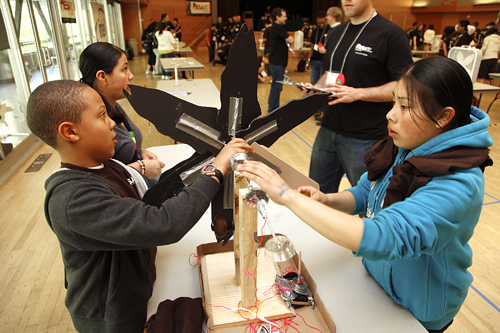Yesterday, bright-colored signs bearing the words “Warning Genocide Photos Ahead” were the first indication that the scene in the South Park Blocks would be different than a typical day. An eye-catching display showing the effects of abortion with pictures of aborted fetuses, dead bodies and representations of genocide, including photos depicting the Holocaust, was erected in between the Branford P. Millar Library and Neuberger Hall Tuesday.
Abortion display draws eyes
Yesterday, bright-colored signs bearing the words “Warning Genocide Photos Ahead” were the first indication that the scene in the South Park Blocks would be different than a typical day.
An eye-catching display showing the effects of abortion with pictures of aborted fetuses, dead bodies and representations of genocide, including photos depicting the Holocaust, was erected in between the Branford P. Millar Library and Neuberger Hall Tuesday.
The “Genocide Awareness Project,” which continues to be displayed on campus, will end after today. It is sponsored by the Center for Bio-Ethical Reform, which erects the display in cities and college campuses across the nation.
“The goal is to heighten awareness about who the baby is and what abortion does to it,” said Darius Hardwick, the Northwest Director at the Center for Bio-Ethical Reform. “Everyone recognizes that genocide is bad. But nobody realizes that abortion creates victims just like genocide does.”
Hardwick said the display traveled to four universities in the Northwest last year, including Portland State at the beginning of May, and usually visits about a dozen U.S. cities each year.
About a dozen participants stood within a few feet of the display, handing out fliers that detail what they say are the harmful effects of abortion and speaking with those who stopped to gander at the photos for a moment.
Despite the presence of members from NARAL Pro-Choice Oregon near the display, all protesters remained mannerly and no words were exchanged between the two groups or anyone passing through the Park Blocks.
Some students said they experienced an initial feeling of shock and surprise when passing by the graphic display of pictures.
“It’s pretty disturbing,” senior Braden Gast said. “I really didn’t want to sit there and look at it in much detail because it’s pretty disturbing and is not something you want to see every day.”
Other students focused less on the graphic nature of the pictures, including dismembered fetal body parts and dead bodies stacked on top of one another, and instead on the tactics the Center for Bio-Ethical Reform was employing to convey its message.
“I am pretty familiar with the coercive tactics they use,” graduate student Eric Holmes said. “I don’t doubt their virtue and mission, but, at the same time, they’re using a really overt and grotesque way to make their argument. So it is coercive as opposed to persuasive.”
In response to students’ claims that the display is graphic and disturbing, Hardwick said that U.S. society is accustomed to seeing graphic images frequently. The reason people respond to the photos in the display, he said, is because they prick the conscience of viewers.
In response to the abortion display, a pro-choice coalition comprised of NARAL, the Women’s Resource Center and the Voices of Planned Parenthood (Vox) student group was formed.
The pro-choice coalition was asking for signatures on a petition for medically accurate and unbiased information to be presented on campus. Gathering signatures for the petition was going well, said sophomore and NARAL campus organizer at PSU Tallina Long, and the group plans to present it to Portland State interim President Michael Reardon.
In addition to the petition, the pro-choice group was suggesting that students donate a particular amount of money for every hour the Genocide Awareness Project is on campus. All proceeds from the donation effort will go toward NARAL’s Spring Adams Fund, which pays for traveling and lodging expenses for women getting an abortion.
While most students said they were shocked by the display, many also stated that because of the First Amendment, the Center for Bio-Ethical Reform has a right to free speech and should be allowed to present its messages in a public place.
“The First Amendment was created for people that had unpopular messages. The whole point of the First Amendment is for people who would otherwise be shut up because people don’t agree with them,” Hardwick said. “Most people don’t agree with us and don’t want to see these pictures. But unless we see these pictures, we won’t have a clear understanding of what abortion is.”



